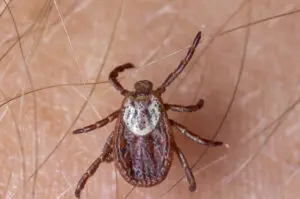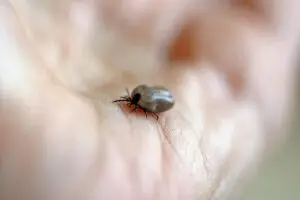

Pests do not belong in any industry, least of all food service. When they find their way into restaurants, pests inevitably lead to foodborne illnesses. Read on to learn about foodborne illnesses, the pests that cause them, and how to prevent both.
Foodborne Illnesses Caused by Pests
Food Poisoning
Food poisoning is an umbrella term for all foodborne illnesses. It is most often caused by consuming foods contaminated with infectious organisms or their toxins. Such organisms include bacteria, parasites, and viruses. Symptoms vary depending on what organism caused the illness, but the most common symptoms are nausea, vomiting, diarrhea, fever, and stomach cramps. Food poisoning is very common and affects more than 3 million people each year in the United States. The following are a few of the most common forms of food poisoning caused by pests.
Salmonella
Salmonella is the bacteria that causes typhoid fever, paratyphoid fever, and most commonly, salmonellosis. Typhoid and paratyphoid are not common in the U.S. and are almost always contracted internationally. Salmonellosis, on the other hand, is quite common, infecting around 1.35 million people in the U.S. every year. Most cases are caused by contaminated food. Symptoms typically begin between 6 hours and 6 days after infection, though in some cases they take several weeks to appear. Symptoms usually go away on their own within 4 to 7 days, but they may last for several weeks.
E. coli
Similar to salmonella, E. coli is a bacteria with a number of different strains. Many strains are harmless and naturally occur in our intestines. Some types are not so harmless and their symptoms range in severity. Symptoms can appear anywhere from 1 day to more than a week after exposure, and usually clear up within a week. E. coli causes around 265,000 illnesses per year in the United States. Roughly 5-10% of those cases lead to a life-threatening form of kidney failure.
Staphylococcal (Staph) food poisoning
Staph food poisoning affects an estimated 240,000 people in the U.S. each year. Approximately 25% of people have Staph bacteria on their skin, and it is usually harmless. However, these bacteria can produce a toxin that causes Staph food poisoning. Symptoms start suddenly between 30 minutes and 8 hours after eating contaminated food and do not usually last longer than a day. Severe illness from Staph food poisoning is rare.
Common Foodservice Pests
Cockroaches
Cockroaches like to live in dark, moist areas like kitchens, basements, and bathrooms. They particularly enjoy food prep areas, cardboard boxes, cabinets, cupboards, garbage cans, food storage areas, and underneath appliances. Signs of an infestation include exoskeletons, eggs, cockroaches, or droppings, which look like coffee grounds. Cockroaches carry an astounding 33 types of bacteria, 7 human pathogens, and 6 types of parasitic worm. Some of the illnesses they cause are dysentery, listeriosis, plague, salmonellosis, and typhoid fever.
Rodents
Rodents prefer to live in cluttered areas like storage rooms, attics, basements, and offices. They also commonly nest in wall, ceiling, and floor voids. They use protected runways to travel to and from food sources. Runways are often beneath appliances, behind shelves, or in cabinets. Signs of rodent activity include droppings, gnaw marks, damaged products or packaging, grease marks, nests, and scratching noises in the walls, ceiling, or floor. Rodents can cause a number of diseases, like salmonellosis, plague, leptospirosis, tularemia, infectious jaundice, lymphocytic choriomeningitis (LCM), and hantavirus pulmonary syndrome which can be fatal.
Flies
Flies are some of the most visibly active pests. They can usually be seen around garbage cans and decaying organic material (i.e. overripe fruits and vegetables or expired meat), but they can also be found in food prep areas and around drains or leaky pipes. Fly infestations are usually indicated by the flies themselves, but you may also see larvae and droppings. Flies are known to carry more than 100 pathogens, including dysentery, cholera, typhoid fever, anthrax, tularemia, tuberculosis, leprosy, poliomyelitis, and yaws.
Ants
Ants usually live in kitchens, bathrooms, cabinets, wall voids, and behind baseboards. Ant trails, ant carcasses, nests, small dirt piles, and large numbers of ants are all sure signs of an infestation. Though not quite as dangerous as other food service pests, ants can still carry and transmit E. coli, salmonella, staph, and shigella.
Stored Product Pests
Stored product pests are any bugs that infest stored products like cereal, flour, powdered sugar, rice, and wheat. Some such pests are beetles, moths, and mites. Beyond contaminating foods with their droppings, exoskeletons, and eggs, they also carry diseases like lyme disease.
Pest Prevention Methods
Pests are often the reason for food poisoning, which means pest prevention is one of the most important steps in avoiding foodborne illnesses. Here are some tips to help pest-proof your establishment:
- Block all entryways. Seal any cracks in the foundations and walls, as well as those around doors and windows. Place covers over chimneys and vents, and replace missing shingles promptly. If possible, create a perimeter around your business with gravel or rock.
- Keep all food prep and storage areas clean. This means cleaning up all food residue, cleaning equipment and storage containers regularly, and washing all dishes before locking up for the night. Try to keep clutter to a minimum in all areas of your establishment.
- Store all of your food products properly. Everything should be in airtight containers made of hard materials that cannot be chewed through by rodents. Products should be stored at least six inches off of the floor and away from the walls.
- Seal appliances and equipment to the floor, or keep them at least six inches off the ground.
- Empty indoor garbage cans each night and keep outdoor garbage cans a distance away from the outside of your establishment if possible- the further away the better. Keep tight-fitting lids on all outdoor garbage cans.
- Fix all leaks and clogs in a timely manner.
- Check all incoming boxes and packages for any hitchhiking pests. Check the contents as well before introducing the new products to your storage rooms.
- Train your staff in proper pest prevention, including what signs to look for and report. In addition to monitoring for pest activity, schedule routine inspections and, if necessary, treatments.
Illness Prevention Precautions
In combination with pest prevention, keeping up with food hygiene regulations is the best way to prevent foodborne illnesses. Train your staff in proper food safety, food storage, and cleaning methods. Dispose of expired ingredients immediately and properly, never cross-contaminate, keep all food storage and prep areas clean, and make sure everything in your establishment is up-to-code. For more information about food safety in restaurants, visit foodsafety.gov.
If pest prevention methods don’t seem to be doing the trick, give Excel a call! We’ll work with you to build a plan tailored to your establishment’s needs.






